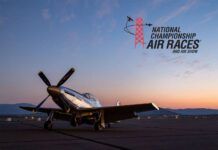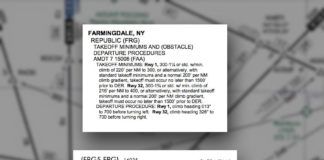Electric Beaver Flies
Harbour Air flew a De Havilland Beaver on floats on pure electric power for the first time in early December as the first step in its program to fully electrify its fleet of historic seaplanes. The Vancouver-based airline serves dozens of communities off British Columbia’s west coast and most of its flights are 30 minutes or less so the company believes new advances in battery technology will enable it to safely carry out the dozens of commercial passenger flights it operates every day. The December flight was a demonstration of the motor in a plane near its gross weight with batteries and lasted about 15 minutes. CEO Greg McDougall lifted the almost-70-year-old airframe off the Fraser River and later reported that it flew like a Beaver. He said newer, lighter batteries that are becoming available will allow room for passengers and cargo and the savings on maintenance and downtime will ultimately pay off.
Mooney Reopens
Mooney reopened its Kerrville, Texas factory on Dec. 2, almost three weeks after a surprise shutdown briefly suspended production. The company has been tight lipped about what led to the closure although a spokesman did tell local media that Mooney is in talks with a new investor. The company did not return media enquiries during the shutdown although there have been reports a small group of employees was at work filling parts orders. There are about 11,000 Mooneys flying.
Textron Layoffs
Textron Aviation is laying off hundreds of workers, mostly in the engineering department, now that the Longitude, its flagship business jet, is being delivered. Textron doesn’t have a replacement development program to keep the engineers busy so they’re being shown the door to save money. The reductions were part of a company-wide effort to pare costs. The company spent about 10 years developing the Latitude and Longitude mid-sized jets to match new offerings from its competitors. Textron has two major development projects under way: the single-engine Denali utility aircraft and the SkyCourier cargo twin, both of which will fly next year.
MAX Production Suspended
Boeing suspended production of the 737 MAX airliner after some pointed discussions with FAA Administrator Steve Dickson. The new administrator told Boeing in early December that the FAA would not be clearing the MAX for flight by the end of the year, as Boeing had hoped, and wouldn’t give an estimated timeline. In the nine months since the grounding of the MAX following two fatal crashes, Boeing continued production at the rate of 42 a month and it has more than 400 completed airliners in storage at Seattle-area airports and in Moses Lake, Washington. The production interruption will ripple through the world economy and could lead to thousands of layoffs in the 900 companies that make parts for the MAX.
Quiet Supersonic Advances
NASA’s idea for a socially acceptable supersonic aircraft could fly in early 2021. The X-59 Quiet Supersonic Technology (QueSST) has been cleared for final assembly and systems integration at Lockheed Martin’s Skunk Works facilities in Palmdale, California. Lockheed Martin won the $247.5 million contract to build the plane in 2018. The plan is to create a design that will be able to go supersonic over land while minimizing the amount of noise from its sonic boom that reaches the ground. The FAA now bans civilian aircraft from going supersonic over the U.S. and that’s the main regulatory hurdle in the way of developing new aircraft. The X-59 will help regulators establish new rules to enable commercial supersonic air travel over land.
NOTAMS
Bill Harrelson broke the record for a westbound circumnavigation flying his Lancair IV around the world in five legs over eight days … Embraer flew its E175-E2 airliner for the first time … The FAA is adding a safety division to bolster aircraft certification … Delta Airlines and Wheels Up have formed a private aviation partnership … See www.avweb.com for breaking news in general aviation.
1. If you don’t get IFR (The magazine for the accomplished pilot), you should. It keeps the juices flowing and is chock full of insights mainly for instrument flying.
2. I think we get the instrument rating mainly to learn more about weather flying (beyond scud running in marginal VFR, or worse). Once we have learned a lot about weather and how to safely get through the clouds on the way up and then again on the way back down, we learn how to carefully plan an IFR flight, and how to work with ATC to make that plan work quite well most of the time. Only then, do we know so much we don’t scud run anymore, and don’t fly in really bad weather anymore eithersometimes scared to make iffy trips because we now know more about ice and other bad stuff.
3. The article on Page 9 of the November issue (TERPS 101) is full of detail about how approach charts are created. Even admitting that sometimes rare chart mistakes occur (pilot beware!), mostly, we can fly the charts down to a safe landing, assuming our plane’s equipment is all working, but we should be awarevery awarethat there might be obstacles just below us in the clouds, so don’t push it.
These words at the end sum up the article’s intent: …the critical point to take away is that every one of the details that are found on those forms and our approach charts is there for a reason. For instance, if you notice something different about a procedure, such as an ILS that doesn’t have a 200-foot decision height, or a missed approach point some distance from the runway, that should be a cue to you that something is going on behind the scenes.
…the backstory about how those details are determined and how much obstacle protection you’re afforded will make it easier to blindly trust the procedure next time you’re in the soup, and make you think twice about second guessing it.
Howard Abraham
Loveland, CO
Nice ACS Change
I noted an interesting change to the Instrument Rating ACS released back in June last year. It used to be that per the ACS, a circling approach required a heading change of at least 90 degrees from the final approach course to the landing runway. That requirement is now gone, replaced with the requirement to Visually maneuver to a base or downwind leg appropriate for the landing runway and environmental conditions. Also, new language was added saying the pilot must not bank over 30 degrees.
I believe these are positive changes that you might want to know about.
Luca Bencini-Tibo
Weston, FL
Interesting and positive changes indeed. Thanks, Luca.
But, I Fly at Night
Thanks for TERPS 101 in the November issue. But I’m still seeking a clue as to why all approaches are NA at night to KLNS Runway 13 and 31. An unlit obstruction? Non standard runway markings? The local controllers and a local FAASTeam rep are wondering too.
Thanks. Keep up the great work.
Mike Jacoby
Lancaster, PA
We asked our resident TERPSter. He dug into it and replied:
This is due to multiple unlit 20:1 visual area penetrations (trees) off the ends of those runways. One possible way to mitigate that could be to require use of the VGSI. That requires the VGSI surface to be clear, and for the operation to be approved by Flight Standards.
So, if you want an approach at night, chop down those trees!
Skew Me
I’ve been a long-time subscriber and endured more than a few articles about the Skew-T chart. I’ve spent many hours trying to get them. I still don’t.
Am I your only reader who just doesn’t understand these charts?
I get that they’re probably a useful tool to use before a flight to get a good understanding of what to expect. But, even with the chart in one hand and multiple articles in the other, it takes me longer to get anything out of these charts than the flight would take.
How about Skew-T for the non-meteorologist? And if that doesn’t work, stop teasing me with articles about a cool tool that I can’t use.
By the way, I’ve never had a Skew-T discussion with a fellow pilot when considering a flight. So, I don’t think I’m in the minority here.
Eddie Esserman
St. Simons Island, GA
Yes, the Skew-T Log P diagram is a dense presentation of a lot of information. You are not alone in not understanding it, or not understanding it well. Because of your note, our resident meteorologist will take another stab at it with a working title of Skew-T Simplified.
As you can see from Just Ahead on Page 2, this is slated for next month. It looks like it’ll be a two-part article, with the first part going over the basics again, and the second part a step-by-step on how to apply itkind of a see this, expect that approach. We hope this proves more helpful.
But, please understand that this isn’t a diagram you can glance at and instantly get an idea of the weather; it does take practice and some analysis.





